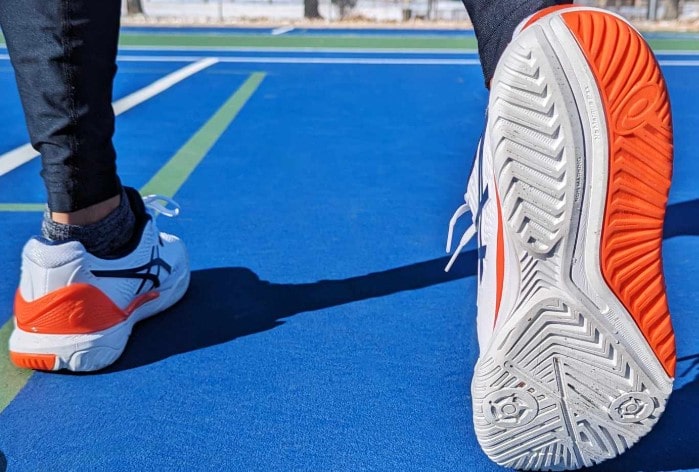When it comes to choosing the perfect footwear for pickleball, a common question arises: Should pickleball shoes be snug? As the sport gains popularity, players are increasingly focused on optimizing their performance and minimizing the risk of injury. A significant part of this involves selecting the right shoes. In this comprehensive guide, we will delve into whether pickleball shoes should be snug, how tight they should be, and the key factors to consider when making this important decision.
The Importance of Properly Fitting Pickleball Shoes

>>> See More: How Pickleballs Are Made: The Fascinating Process Behind the Game
Pickleball is a dynamic sport that involves quick lateral movements, abrupt stops, and rapid changes in direction. Having well-fitting shoes is crucial to:
- Enhance Performance: Properly fitting shoes help improve agility and speed on the court.
- Prevent Injuries: Ill-fitting shoes can lead to blisters, sprains, and other foot injuries.
- Provide Comfort: Long matches require footwear that doesn’t cause discomfort or distraction.
Let’s explore what snugness means in the context of pickleball shoes and why it matters.
What Does “Snug” Mean?
In the realm of athletic footwear, a “snug” fit refers to a shoe that:
- Hugs Your Foot: The shoe should feel secure without being overly tight or restrictive.
- Prevents Excessive Movement: There should be minimal slippage or unnecessary room for your foot to move inside the shoe.
- Feels Comfortable: While snug, the shoe should not cause pain or pressure points.
A snug fit is essential for activities like pickleball where stability and quick footwork are paramount. But how snug is too snug? Let’s address this.
Should Pickleball Shoes Be Tight?
The keyword should pickleball shoes be tight often leads to confusion among players. While snugness is ideal, tightness can be problematic. Here’s a breakdown:
Signs Your Shoes Are Too Tight:
- Pinching or Numbness: If your toes feel cramped or you experience numbness, your shoes are likely too tight.
- Blisters: Excessive pressure can cause friction, leading to painful blisters.
- Restricted Blood Flow: Tight shoes can impede circulation, resulting in discomfort and potential long-term issues.
Ideal Fit Guidelines:
- Toe Room: Ensure about a thumb’s width of space between your toes and the front of the shoe.
- Heel Security: Your heel should stay in place without slipping.
- Midfoot Support: The shoe should wrap snugly around your midfoot to provide stability.
Factors to Consider When Choosing Pickleball Shoes
Foot Shape and Size
Everyone’s feet are different. Some players have wide feet, while others have narrow ones. Consider these tips:
- Measure Your Feet: Always measure both feet and choose the size that accommodates the larger one.
- Consider Width Options: Some brands offer shoes in varying widths to cater to different foot shapes.
Material and Stretch
The material of the shoe affects how snug it feels:
- Leather: Offers durability but less stretch.
- Mesh: Lightweight and breathable, often providing more flexibility.
- Synthetic Blends: Combine comfort and structure, making them ideal for pickleball.
Brand and Fit
Different brands have unique sizing and fit. Popular pickleball shoe brands like Asics, Nike, and K-Swiss may fit differently. Trying on multiple brands can help you find the best fit for your foot.
Playing Surface
Consider the type of court you play on:
- Indoor Courts: Shoes for indoor surfaces often have a smoother sole for better grip.
- Outdoor Courts: Require shoes with more durable outsoles to handle rough surfaces.
How to Test the Fit of Pickleball Shoes
Wear Your Socks
Always try on shoes with the socks you intend to wear during games. This ensures an accurate fit.
Walk and Move Around
Walk, jog, and mimic lateral movements to assess comfort and stability. Pay attention to any pinching or slipping.
Check Flexibility
The shoe should bend naturally at the ball of your foot. If it feels stiff or unyielding, it may not be suitable for pickleball.
Evaluate Long-Term Comfort
Wear the shoes for at least 15–20 minutes to gauge how they’ll feel during extended play.
Tips for Maintaining the Perfect Fit
- Break Them In: Even the best-fitting shoes may require a short break-in period. Wear them during light practice sessions before full matches.
- Replace When Necessary: Shoes lose their snug fit over time. Replace them every 6–12 months, depending on frequency of use.
- Use Insoles: Custom insoles can enhance fit and comfort, especially for players with high arches or flat feet.
Conclusion
So, should pickleball shoes be snug? The answer is yes, but not overly tight. A snug fit ensures stability, comfort, and enhanced performance on the court. However, avoid shoes that feel restrictive or cause pain. By considering factors like foot shape, material, and playing surface, you can find the perfect pair for your needs.
Thank you for reading this guide on pickballtips.org. We hope this article helps you make an informed decision and enjoy your time on the pickleball court. Happy playing!
